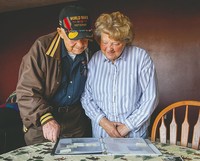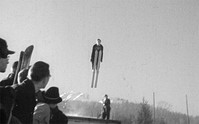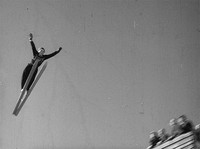Cloudy, 26° F
Levandoski, now 91, began ski jumping as a boy in Wisconsin, and he was a natural. When he was 12 years old, he won an honorable mention at a ski-jump competition with a jump of 92 feet.
But by the age of 18, ski jumping became much more than a …
This item is available in full to subscribers.
The Powell Tribune has expanded its online content. To continue reading, you will need to either log in to your subscriber account, or purchase a subscription.
If you are a current print subscriber, you can set up a free web account by clicking here.
If you already have a web account, but need to reset it, you can do so by clicking here.
If you would like to purchase a subscription click here.
Please log in to continue |
|



Skiing off a ledge and soaring through the air until gravity brought him down was both a challenge and a thrill for Jack Levandoski of Powell.
Levandoski, now 91, began ski jumping as a boy in Wisconsin, and he was a natural. When he was 12 years old, he won an honorable mention at a ski-jump competition with a jump of 92 feet.
But by the age of 18, ski jumping became much more than a thrill. It was a lifeline — a way to cope with haunting memories of combat and horror from World War II.
Into the battle
Levandoski joined the Army at the age of 17, lying about his age to enlist.
After training, Levandoski was sent to France. On his way to the battlefront, his first experience involved walking past thousands of crosses that marked the graves of soldiers who never made it to the shoreline at Normandy on D Day, June 6, 1944 — just a few months earlier.
His first combat experience came at the Battle of the Bulge — Germany’s last major offensive campaign on the Western Front, and the costliest battle of the war in terms of American casualties.
According to Wikipedia, the surprise attack caught the Allied forces completely off guard. During the 40-day battle — fought in eastern Belgium, northeast France and Luxembourg from Dec. 16, 1944 to Jan. 25, 1945 — more than 76,000 American soldiers were killed, wounded and went missing in action, according to the U.S. Department of Defense.
When asked about his experience at the Battle of the Bulge, Levandoski had little to say. The memories are still too difficult to think about or express.
“It wasn’t pretty, let’s put it that way,” he said. “They threw their crack troops at us. There were a lot of instances that were pretty rough.”
He told of one time when his outfit was going to dig in by a dike, and the commanding officer told the soldiers to move away from the structure and dig in farther down, next to the water.
“I seen why that night,” he said. “The Germans had big mortars — 300-something [millimeters in diameter]; we had the 80 size. They shot the heck out of that dike. ... We wouldn’t have stood a chance. They just took that dike and just leveled it.”
Another time, after the Battle of the Bulge, Levandoski’s unit was bottled up, waiting for Army engineers to lay slabs where a bridge had been blown out.
“They [the Germans] made believe they were moving out. ... They were stragglers, it looked like. But they were carrying something heavy, and they were not stragglers.”
Levandoski was with a small group of soldiers that spotted the Germans, and they notified the commanding officer.
“They had two heavy machine guns. They were going to set them up on both sides of us, and they were going to crossfire at us.” If that had happened, “we wouldn’t have had a chance,” he said.
Germany suffered even higher casualties at the Battle of the Bulge — and the loss of those troops left the German army decimated. As the Allies moved into Germany, the depleted troops gave little resistance.
“When they did surrender, it was easy,” Levandoski said. “They didn’t want to fight no more. They knew Germany was on the way down.”
Levandoski and his unit “were going through a lot of towns; we didn’t ever know the names of them,” he said. “We kept the Germans on the move going back, pretty much.”
‘They were merciless’
Levandoski was with the troops who liberated Dachau in Bavaria, Germany — and a horror they could never have imagined.
“I couldn’t believe it,” he said. “We didn’t know there had been concentration camps.”
In the Nazi camp, the soldiers found hundreds of emaciated prisoners. Those who had the strength greeted them at the fence, a look of joy on their faces as they realized liberation was finally near.
That moment is frozen in time in a photograph Levandoski took to document it.
“They were so undernourished, they were skin and bones,” he said. “You’d see pregnant women there ... with a little biddy bulge like this, ready to deliver,” Levandoski said, gesturing a round shape about the size of a large grapefruit. “There was no way the baby would survive.”
The other photos he has are as far from joyous as it is possible to get: Railroad boxcars littered with dead bodies piled or strewn across the floor; naked bodies piled high in a cement room.
“Bodies were piled high as this room here,” he said. “They didn’t get a chance to cremate them. ... It was unbelievable. It was terrible. You can’t take that off your memory.”
And the smells were as gruesome as the sights, he said.
Levandoski was surprised when his daughter, May Rekowski of Powell, said she still had the photos.
“I thought I destroyed those pictures,” he said.
Rekowski said her mother saved the photographs.
“She gave them to me one day and I thought, ‘Well, I’ll store them away.’ ... You have to save Dachau to always have the world remember what took place there,” Rekowski said.
The stories prisoners told of the torture they had endured — and those who hadn’t survived it — were just as horrific, Levandoski said. Men, women and children forced to walk barefoot on acid-covered floors. Prisoners were pushed by dogs into electric fences, where they were electrocuted.
Beyond that, “I ain’t ever going to tell you what kind of tortures they had there,” Levandoski said. “It was terrible. ... They were merciless.”
When soldiers cut the wire fence at Dachau, “we had to take down eight [German] officers. We had to shoot them for mercy’s sake. The prisoners were so angry” that they would have taken matters into their own hands with much less mercy, he said.
Things were so bad at Dachau that, “for three days, I couldn’t hold food down after that,” he said.
After helping to liberate the camp, Levandoski and his unit continued their march through Germany, making it as far as Salzburg, Austria by the time the war in Europe ended.
A return to ski jumping
Physically and emotionally depleted, Levandoski was sent to a rest center in Austria to recuperate. While there, he learned of a ski jump hill in Hofgastein. As he began to recover, he started ski jumping again to strengthen his muscles and rejuvenate his spirit.
“When I was jumping there, some officers for the American team saw me jumping and said, ‘Would you jump for the United States?’” he recalled.
Levandoski was enthusiastic, and they provided him with new skis, ski boots and everything else he needed.
He competed in a tournament at a large Red Cross center. His two jumps were “way out in the flats,” and he won first place. After that, “they hired the second-best jumper just to go with me, keep my skis waxed and tell me if I was doing something wrong.”
He skied in competitions in France, Italy, Norway, Germany and in Yugoslavia, where he jumped 351 feet.
A doctor told Levandoski that he skied at 92 mph when he began a jump, and he landed at about 70 m.p.h.
“In those days, no helmet, no nothing,” added Rekowski.
One morning, he went out to practice jump skiing. Unbeknownst to him, a light coating of snow had fallen on the track overnight, melted and then frozen “as hard as a rock,” he said. “There’s nothing you can do; you can’t stop. I over-jumped the hill and landed on the flats, and the skis were kindling.”
The snow past the hill was more than a foot deep, and his leg sank in and stayed there, wrenching his hip as the rest of his body continued to move forward.
“I was hurting bad,” he said.
Levandoski spent the next two weeks in a hospital. But, when the time for an international competition came, he decided he had to compete.
“I snuck out of the hospital,” he said. “A friend snuck me a pair of skis, waxed them and had them ready. ... He says, ‘You ain’t going to get away with this.’ I says, ‘We’ll see.’”
Levandoski entered the competition under another name.
“Down [the hill] I went, and I hit it right on the button. I had the longest standing jump on the first round,” Levandoski recalled. “The officer in charge of the ski operation said, ‘What in the world are you doing here?’ He gave me bloody hell. Then he turned around and said, ‘Nice jump, Jack.’”
The officer forbade Levandoski from jumping again, but allowed him to ski the course without jumping.
“Just riding it in the American team put me in fourth place,” Levandoski said.
But that was his last top finish.
“I couldn’t get my timing back,” he said of jumping after the injury. “My mind said I could do it, but my body said no.”
Long after returning to the U.S., Levandoski has remained grateful for his ski jumping experience in Europe. Besides being a challenge and a lot of fun, it helped him deal with the emotional trauma he experienced during the war.
But even so, Rekowski said her father still experiences post-traumatic stress from his World War II days.
“He still has bad dreams,” she said.